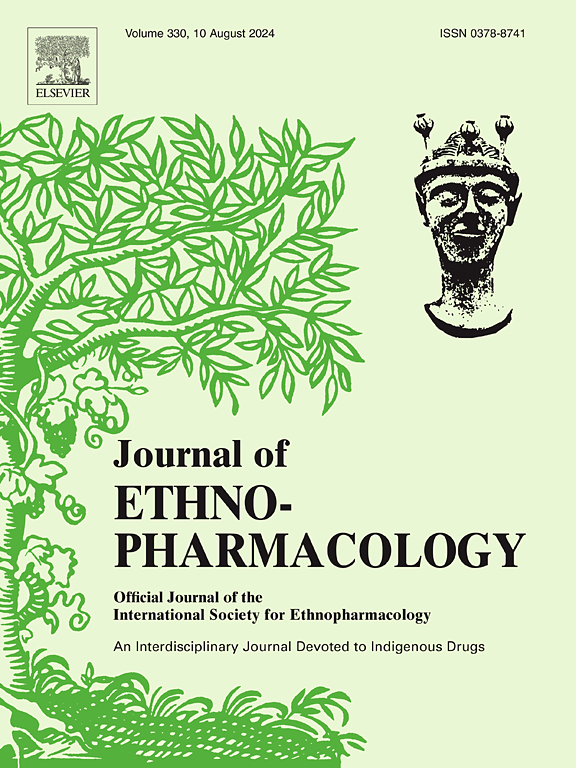Decoding the pharmacodynamics of Fufang Tongye Shaoshang You: A promising ethnomedicine for diabetic ulcer healing
IF 4.8
2区 医学
Q1 CHEMISTRY, MEDICINAL
引用次数: 0
Abstract
Ethnopharmacological relevance
Fufang Tongye Shaoshang You (TYY) is an ethnomedicine derived from the traditional folk formula of the Tujia people in Hunan Province, which consists of Paulownia leaf and sesame oil, has shown promising potential in promoting diabetic ulcer (DU) healing. However, its pharmacological substance and mechanism of action require further elucidation.
Aims of the study
This study was designed to assess the healing effect of TYY on DU wounds in mice, and to explore systematically its potential mechanisms and pharmacodynamic material basis.
Methods
The combination of high-fat, high-sugar diet and streptozotocin injection was used to induce C57BL/6 J mouse diabetic model, and the ulcer was surgically introduced. After TYY treatment, the skin lesions of diabetic mice were observed by H&E, Masson staining and transmission electron microscopy over a period of time. The wound tissues were collected. Transcriptomics were used to predict the potential mechanism of TYY, and then immunohistochemistry, immunofluorescence, ELISA, Western blotting, and qRT-PCR were used to detect the expression levels of key proteins and mRNA in related signaling pathways. The effect of TYY on tight junction proteins was evaluated by Western blotting. The chemical components of 10 batches of TYY were analyzed by multivariate analysis, and the iconic components of TYY were screened by molecular docking and dynamics simulation. HMEC-1 cells were induced by lipopolysaccharide and high glucose concentrations to simulate a DU microenvironment and construct an endothelial cell injury model. Scratch test and RT-qPCR were used to evaluate the effects of TYY active ingredients on the endothelial cell injury model, finally determining the pharmacodynamic material basis of TYY.
Results
The study has demonstrated that TYY can not only effectively repair the skin barrier, but also regulate the IL-17-mediated NF-κB/AP-1 signaling pathway, inhibit the exacerbation of inflammation, and accelerate wound healing in DU mice. In addition, we further discovered the key active ingredients of TYY: maslinic acid, corosolic acid, oleanolic acid, ursolic acid and sesamin.
Conclusion
This study provides scientific evidence for TYY as a potential drug to repair DU, and also provides a theoretical basis for its further clinical application and drug development.

复方通液少伤油的药效学研究:一种治疗糖尿病溃疡的有前途的民族药。
民族药理学相关性:复方通叶少伤油(TYY)是由湖南土家族传统民间配方衍生而来的民族药,由泡桐叶和香油组成,具有促进糖尿病溃疡(DU)愈合的潜力。但其药理物质和作用机制有待进一步阐明。研究目的:本研究旨在评估TYY对小鼠DU创面的愈合作用,并系统探讨其潜在机制和药效学物质基础。方法:采用高脂高糖饮食联合注射链脲佐菌素诱导C57BL/6J小鼠糖尿病模型,并手术引入溃疡。经TYY治疗后,用H&E、Masson染色、透射电镜观察糖尿病小鼠一段时间内的皮肤病变情况。收集创面组织。利用转录组学方法预测TYY的潜在机制,然后利用免疫组织化学、免疫荧光、ELISA、Western blotting、qRT-PCR检测相关信号通路中关键蛋白和mRNA的表达水平。Western blotting检测TYY对紧密连接蛋白的影响。通过多变量分析对10批TYY的化学成分进行分析,并通过分子对接和动力学模拟筛选TYY的标志性成分。采用脂多糖和高糖诱导HMEC-1细胞模拟DU微环境,构建内皮细胞损伤模型。采用划痕试验和RT-qPCR评价TYY有效成分对内皮细胞损伤模型的影响,最终确定TYY的药理学物质基础。结果:研究表明TYY不仅能有效修复皮肤屏障,还能调节il -17介导的NF-κB/AP-1信号通路,抑制炎症加重,加速DU小鼠创面愈合。此外,我们还进一步发现了TYY的关键活性成分:山茱萸酸、柯罗果酸、齐墩果酸、熊果酸和芝麻素。结论:本研究为TYY作为修复DU的潜在药物提供了科学依据,也为其进一步的临床应用和药物开发提供了理论依据。
本文章由计算机程序翻译,如有差异,请以英文原文为准。
求助全文
约1分钟内获得全文
求助全文
来源期刊

Journal of ethnopharmacology
医学-全科医学与补充医学
CiteScore
10.30
自引率
5.60%
发文量
967
审稿时长
77 days
期刊介绍:
The Journal of Ethnopharmacology is dedicated to the exchange of information and understandings about people''s use of plants, fungi, animals, microorganisms and minerals and their biological and pharmacological effects based on the principles established through international conventions. Early people confronted with illness and disease, discovered a wealth of useful therapeutic agents in the plant and animal kingdoms. The empirical knowledge of these medicinal substances and their toxic potential was passed on by oral tradition and sometimes recorded in herbals and other texts on materia medica. Many valuable drugs of today (e.g., atropine, ephedrine, tubocurarine, digoxin, reserpine) came into use through the study of indigenous remedies. Chemists continue to use plant-derived drugs (e.g., morphine, taxol, physostigmine, quinidine, emetine) as prototypes in their attempts to develop more effective and less toxic medicinals.
 求助内容:
求助内容: 应助结果提醒方式:
应助结果提醒方式:


